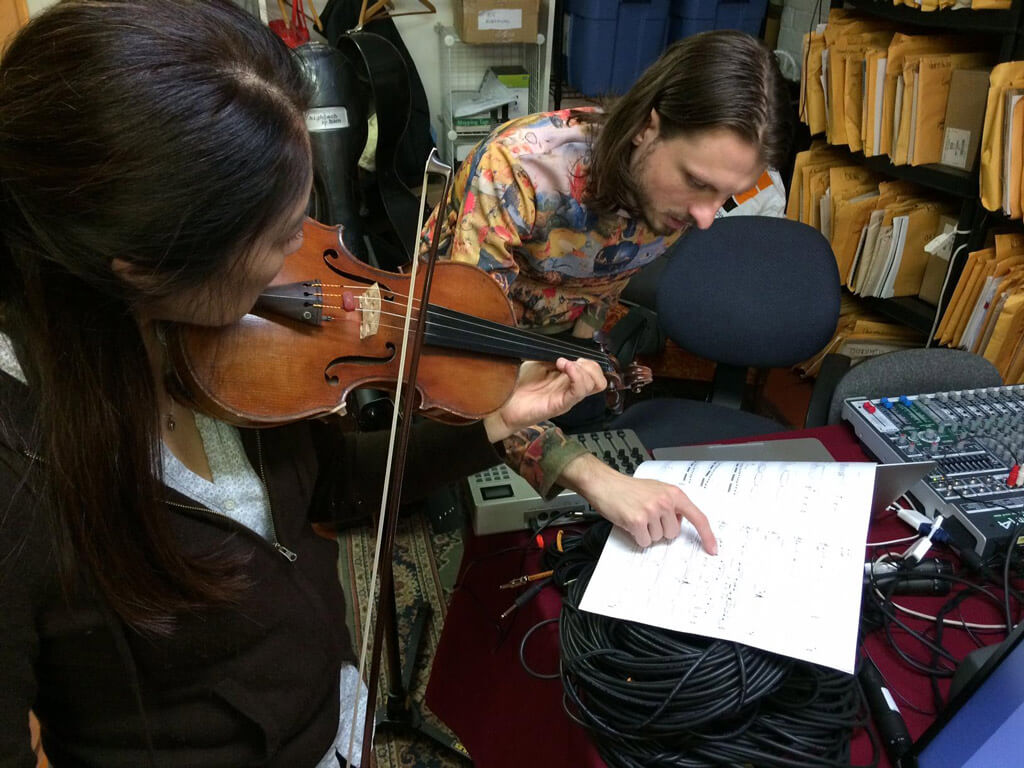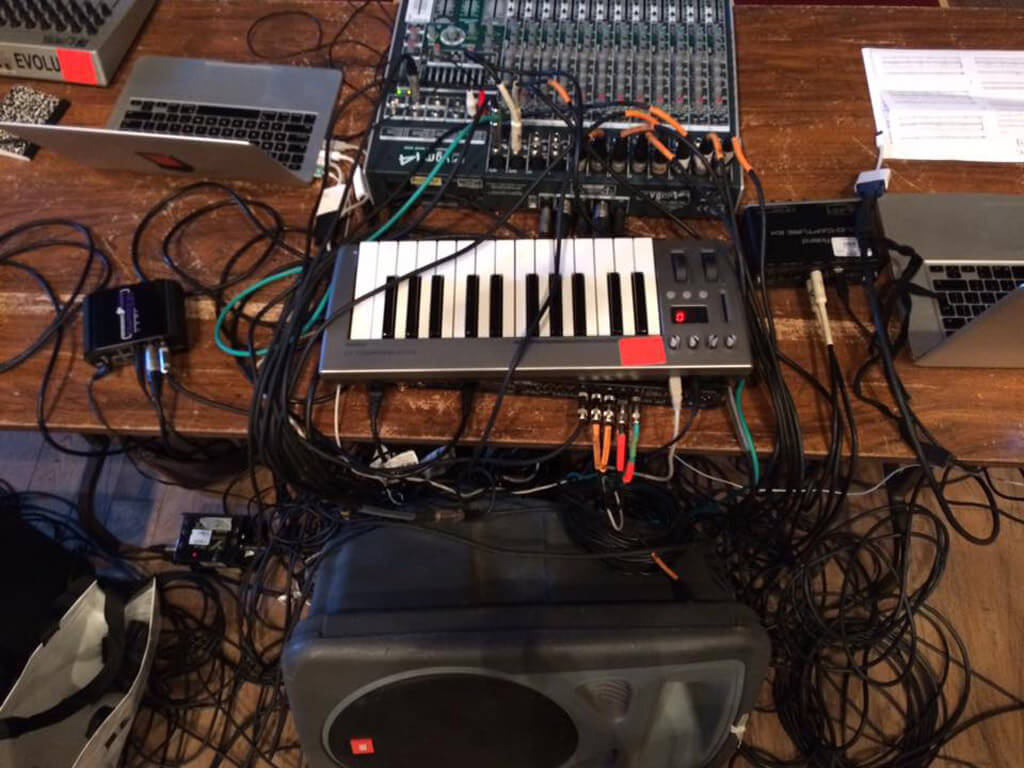
Continuum Contemporary Music at the Music Gallery. Nov. 13
I have no problem saying this: Continuum’s concert from last night, ravAGE, might be one of my favorite new music concerts of the year. It is possible that I am just easily impressed with the usage of multimedia and electronics. Even if that were the case, art and technology, in the current age are almost inseparably linked, so to hear a concert of nothing but such works make it feel particularly contemporary. That and all the music was written within the last two years. This is not to say that each piece was entirely unique. Several explored the concert space, several emphasized malfunction and glitch in technology, and elements of post-minimalism and timbral exploration. But this is an advantage. Each composer presents a unique perspective as to what it means to write music in the 2010s.
The first piece, Jagoda Szmytka’s empty music, makes no apologies for its inspiration in the absurd. She cites in her note influences of her experience of administration in the business of opera. Whether this comes across in the music is not for me to say. Her musical and visual language convey elements of this kind of impersonalness and absurdity, making usage of malfunctioning and glitching technology. The music and visuals are rife with the relics of digital medium. She uses electronic buzzes and video clips ranging from pure static, failing VHS artifacts, and dated computing and games (drawing influence from Atari to Minesweeper). She creates a dialog between the video, electronics, and instrumentalists. At times, the music leads the video and vise versa. Same with the electronics and the instrumentalists — she blurs which is “ensemble” is leading. This becomes far more overt as a synthesized voice begins to bark commands at the players compelling them to either play on or literally stop playing.
Among am a, by James O’Callaghan (who was the night’s unsung hero as he was behind the mixer for the duration of the concert) is, by contrast, not focused on digital culture and artifice. Instead, he uses the acoustic space of the hall, achieved by using stereophonic electronics as well as off-stage noise, as an instrument in of itself. Originally, this piece was composed for a different space. I can’t help but feel that the Music Gallery was ill-suited for such a piece as the offstage noises came from only one direction. Even considering this, O’Callaghan still displays an immersive and compelling range of sounds comprising of idle chatter to off stage banging that positionally moves. The effect is ghostly. Sudden outbursts of full volume sound as well as a gasping flutist help in creating an anxiety driven atmosphere. The final gesture of the piece, in which the performers wander into the aisles and collapse onto the floor, elicited some smiles and even a chuckle here or there. O’Callaghan cites that he meant to address his own anxieties of crowds, so it seems apropos for it to end with the performers falling into one.

Colliding Galaxies: Colour and Tones by Nicole Lizée is the polar opposite. O’Callaghan’s music was driven by anxiety and atmosphere. Lizee’s music is comparatively extroverted. This is not to say Lizee’s music is simplistic by comparison, quite to the contrary. There’s always this sense of momentum that is not always present in the prior pieces. Her orchestration is decidedly more subtle as it is not the primary focus and is used to highlight a post-minimal groove. Lizée’s video components usually have a DIY feel, and this is no exception. I wonder if having a more polished film would have been preferable, but at the same time, the overt roughness and even goofiness make it fitting. If everything were clean, an element of authenticity would be lost. Her electronics emphasize down-sampling and coarse bit-crushing, a staple digimodern technique. After all, it seems to be mostly Gen X composers and artists that are so keen on revisiting the outmoded nostalgia and technology of their youths. The video is a collage of her own footage interspersed with brief clips from 2001: A Space Odyssey and Solaris which flicker in a nauseating fashion. This sort of “I just learned how to use after-effects” quality to her editing is to her advantage. I would have it no other way. The totality of her art is infectious and charming but with enough intellectual weight and technique that it commands your attention and respect.
The fourth piece stands as perhaps the most divergent from the rest of the concert. It does not have a video element nor does it contain clear artifacts of digitalization. It features a smaller ensemble consisting of only cello, bass, and four sample keyboards. But, Christopher Mayo’s Supermarine still makes for much-needed variety and is a fantastic piece of music. Mayo states that his samples come from a documentary about legendary aviation engineer R. J. Mitchell. We have to trust Mayo because the sample is so destroyed in the sampling process that it could be from anything. The other pieces featured standard elements of rhythm, harmony, and timbre. Mayo’s music emphasizes drone. Due to the nature of his destroyed sample and the stereophonic effects of his electronic part, he creates a coarse and even painful soundscape. But, the cello and bass provide a grounded melodic and acoustic contrast to the largely toneless electronics. Not that there is no pitch to the electronics, Mayo does create interesting harmonizations. As well Mayo also provides some compelling melodic content toward the end of the piece, again, giving much needed and appreciated contrasts.
The final piece, Pierre Jodlowski’s People / Time, is like a menagerie of movements loosely connected by one cohesive idea: time. It’s perhaps a bit too on the nose–the players start offstage and enter the stage with sounding alarm clocks. Still, this clock motif that accompanies the video of a dying leaf is a defined symbol that ties the whole work together. There are clear poly stylistic elements to his music. Post-minimalism is again on display, but so is a decided jazzy drum solo accompanying a video of driving. The most impressive use of synchronicity of the entire concert comes at the end of the piece. In it, a highly rhythmic instrumental part moves in synch with four turning clocks. As the music becomes more complex, so do the clock’s movements, creating an ad hoc Ballet of rotating clocks. The connected segments of the piece, while perhaps only closely related, do tie together and create a larger cohesive whole, even if that whole is at times overwhelming.
I stand by my initial statement: ravAGE is a triumph of programming and execution. Whatever Faustian pact that was made to create such a cohesive program was worth it. When you have five pieces of amplified instruments and electronics with a video component, you are tempting fate to intervene in the form of at least one technical glitch. But, the execution was nigh flawless (or it at least could have fooled me). Instead, Continuum put on one of the best concerts of the year. Minor complaints might be that some of the music was perhaps long in the tooth, but I’m loath to complain about “too much of a good thing.” There was a lot of “good” on display.



